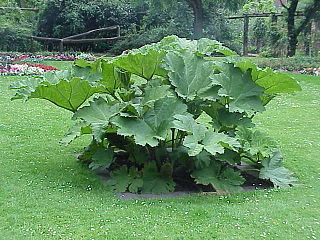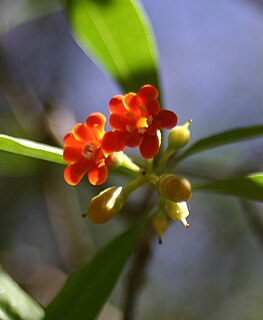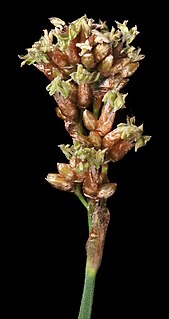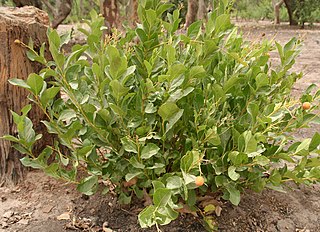
Ledocarpaceae Meyen was a small flowering plant family of shrubs native to western South America. Under the APG III system of classification it is considered to be a part of the Vivianiaceae. [1]

Ledocarpaceae Meyen was a small flowering plant family of shrubs native to western South America. Under the APG III system of classification it is considered to be a part of the Vivianiaceae. [1]

The Alismatales (alismatids) are an order of flowering plants including about 4500 species. Plants assigned to this order are mostly tropical or aquatic. Some grow in fresh water, some in marine habitats.

Commelinales is the botanical name of an order of flowering plants. It comprises five families: Commelinaceae, Haemodoraceae, Hanguanaceae, Philydraceae, and Pontederiaceae. All the families combined contain over 885 species in about 70 genera; the majority of species are in the Commelinaceae. Plants in the order share a number of synapomorphies that tie them together, such as a lack of mycorrhizal associations and tapetal raphides. Estimates differ as to when the Comminales evolved, but most suggest an origin and diversification sometime during the mid- to late Cretaceous. Depending on the methods used, studies suggest a range of origin between 123 and 73 million years, with diversification occurring within the group 110 to 66 million years ago. The order's closest relatives are in the Zingiberales, which includes ginger, bananas, cardamom, and others.

Sapindales is an order of flowering plants. Well-known members of Sapindales include citrus; maples, horse-chestnuts, lychees and rambutans; mangos and cashews; frankincense and myrrh; mahogany and neem.

The Dilleniales are an order of flowering plants, potentially containing one family, Dilleniaceae. The APG III system of 2009, like the earlier APG II system of 2003, left the Dilleniaceae unplaced as to order, while noting that the name Dilleniales was available. Stevens at the Angiosperm Phylogeny Website has subsequently placed Dilleniaceae in the order Dilleniales.

Ranunculales is an order of flowering plants. Of necessity it contains the family Ranunculaceae, the buttercup family, because the name of the order is based on the name of a genus in that family. Ranunculales belongs to a paraphyletic group known as the basal eudicots. It is the most basal clade in this group; in other words, it is sister to the remaining eudicots. Widely known members include poppies, barberries, and buttercups.

Proteales is the botanical name of an order of flowering plants consisting of three families. The Proteales have been recognized by almost all taxonomists.

Ceratophyllaceae is a cosmopolitan family of flowering plants including one living genus commonly found in ponds, marshes, and quiet streams in tropical and in temperate regions. It is the only extant family in the order Ceratophyllales. Species are commonly called coontails or hornworts, although hornwort is also used for unrelated plants of the division Anthocerotophyta.

The Aquifoliales are an order of flowering plants, including the Aquifoliaceae (holly) family, and also the Helwingiaceae and the Phyllonomaceae. In 2001, the families Stemonuraceae and Cardiopteridaceae were added to this order. This circumscription of Aquifoliales was recognized by the Angiosperm Phylogeny Group when they published the APG II system in 2003. In the Cronquist system, there is no Aquifoliales order: the Aquifoliaceae are placed within the order Celastrales and the others are in other families.

The Zygophyllales are an order of dicotyledonous plants, comprising the following two families:
Berberidopsidales is an order of Southern Hemisphere woody flowering plants. The name is newly accepted in the APG III system of plant taxonomy. APG II system, of 2003, mentions the possibility of recognizing the order, as comprising the families Berberidopsidaceae and Aextoxicaceae. However, APG II left the families unplaced as to order, assigning them to the clade core eudicots. The APG III system of 2009 formally recognized the order.

The Gunnerales are an order of flowering plants. In the APG III system (2009) and APG IV system (2016) it contains two genera: Gunnera and Myrothamnus. In the Cronquist system (1981), the Gunneraceae were in the Haloragales and Myrothamnaceae in the Hamamelidales. DNA analysis was definitive, but the grouping of the two families was a surprise, given their very dissimilar morphologies. In Cronquist's old system, and Takhtajan's (1997), the Gunneraceae were in the Rosidae, and the Myrothamnaceae were in the Hamamelids. In modern classification systems such as APG III and APG IV this order was the first to derive from the core eudicots.

The Angiosperm Phylogeny Group, or APG, is an informal international group of systematic botanists who collaborate to establish a consensus on the taxonomy of flowering plants (angiosperms) that reflects new knowledge about plant relationships discovered through phylogenetic studies.

Saururaceae is a plant family comprising four genera and seven species of herbaceous flowering plants native to eastern and southern Asia and North America. The family has been recognised by most taxonomists, and is sometimes known as the "lizard's-tail family". The APG IV system assigned it to the order Piperales in the clade magnoliids.

In the APG IV system (2016) for the classification of flowering plants, the name asterids denotes a clade. Common examples include the common daisy, the forget-me-nots, nightshades, the common sunflower, petunias, yacon, morning glory, sweet potato, coffee, lavender, lilac, olive, jasmine, honeysuckle, ash tree, teak, snapdragon, sesame, psyllium, garden sage, table herbs such as mint, basil, and rosemary, and rainforest trees such as Brazil nut.

Myrothamnus is a genus of flowering plants, consisting of two species of small xerophytic shrubs, in the southern parts of tropical Africa and in Madagascar. Myrothamnus is recognized as the only genus in the family Myrothamnaceae.

Dasypogonaceae is a family of flowering plants, one that has not been commonly recognized by taxonomists; the plants it contains were usually included in the family Xanthorrhoeaceae. If valid, Dasypogonaceae includes four genera with 16 species.

Theophrastoideae is a small subfamily of flowering plants in the family Primulaceae. It was formerly recognized as a separate family Theophrastaceae. As previously circumscribed, the family consisted of seven genera and 95 species of trees or shrubs, native to tropical regions of the Americas.

The Anarthriaceae are a family of three genera, Anarthria, Hopkinsia and Lyginia of flowering plants, now included in Restionaceae following APG IV (2016). The family is accepted in the Angiosperm Phylogeny Group's classification system, APG III system, but is not considered a separate family in many other taxonomic systems. The three genera are herbaceous but differ greatly in characteristics.
Octoknemaceae is a monotypic family of flowering plants endemic to continental Africa. The APG III system of 2009 and the APG II system of 2003, do not recognize this family. The family is recognized by the Angiosperm Phylogeny Website, based on work since the publication of the APG III system.

Icacinales is an order of Angiosperms.